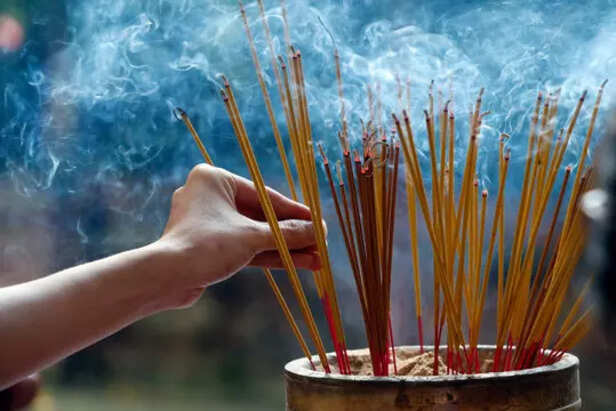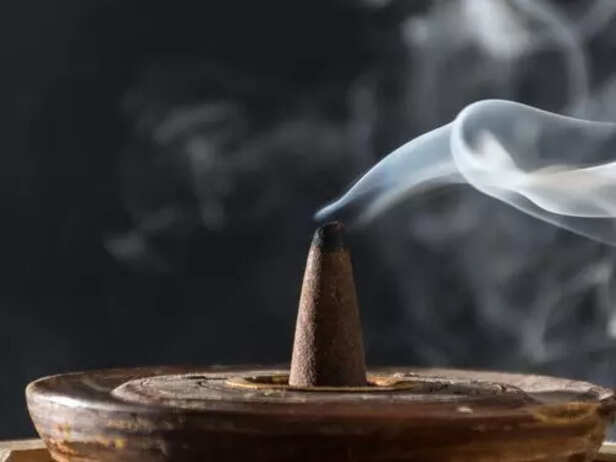Why Scriptures Warn Against Burning Incense Sticks (Agarbatti) at Home
Ankit Gupta | May 01, 2025, 19:46 IST
Incense Stick
According to certain Dharmashastra texts, burning bamboo is considered inauspicious and is believed to invite negative energies or disturbances in ancestral peace (Pitra Dosh). This stems from ancient traditions where bamboo was associated with sacredness, construction, and death rituals—but not fire offerings.
Incense sticks, or agarbattis, have long held a place in Indian households, temples, and spiritual practices. Their fragrant smoke is often associated with sanctity, purity, and divine presence. However, beneath this seemingly harmless ritual lies a deeper scriptural and spiritual concern that many overlook. According to Hindu scriptures and traditional wisdom, burning incense sticks—particularly those made with bamboo—can bring about undesirable spiritual consequences, including the manifestation of Pitra Dosh (ancestral disturbance).
This essay explores the cultural, scriptural, and practical reasons behind the traditional prohibition against burning bamboo and why this applies to modern-day incense sticks. We will also look at alternatives that align better with Vedic practices and offer deeper spiritual benefits.
![Image Credit: Pixel]()
Incense sticks have become nearly synonymous with religious rituals across India. The soothing aroma, the visual elegance of rising smoke, and the calming ambiance they create make them a staple in daily puja (worship) routines. They are believed to purify the air, elevate mood, and serve as offerings to deities. But the widespread use of incense sticks is a relatively modern phenomenon, heavily influenced by industrial manufacturing and commercialization.
Traditionally, offerings in fire rituals (homa or havan) were made using natural substances like ghee, dried herbs, resins (like sambrani and guggal), and cow dung cakes. These items were chosen for their sattvic (pure) qualities and their ability to carry prayers through the medium of fire and smoke. Bamboo, in contrast, was never a part of these offerings.
![Image Credit: Freepik]()
A key source of the prohibition against burning bamboo is found in texts such as the Vishnu Dharma Shastra and Grihya Sutras, where it is clearly stated:
"Vanshaagnim na juhuyat"
(वंशाग्निं न जुहूयात्)
Translation: One should not offer bamboo into the sacrificial fire.
The term "vansha" means bamboo, and "agni" means fire. The rule literally instructs that bamboo must never be burnt in any fire associated with sacred rituals. This directive is not without reason. Burning bamboo is believed to emit spiritually and physically toxic fumes. It is associated with ashubh (inauspicious) vibrations that can disturb the energy of a sacred space.
In the Garuda Purana, which deals extensively with the afterlife and rituals for ancestors, specific materials are prescribed and proscribed during shraddha (ancestral rituals). While the Purana does not directly mention agarbattis, the underlying idea is clear: purity and intentionality in the materials used is crucial to avoid invoking or disturbing energies that should remain at rest.
![Pitra Dosh Remedies]()
Pitra Dosh refers to ancestral imbalances or disturbances caused due to improper shraddha rituals or unfulfilled karmic obligations towards one’s forebears. It is often cited as a cause of repeated misfortunes, unexplained obstacles, or disharmony in family life.
Traditional belief holds that burning bamboo creates smoke that attracts wandering spirits or disturbs ancestral realms. The reason lies both in spiritual vibration and in scriptural avoidance. Since bamboo is traditionally associated with funerals (it is used in constructing biers or for carrying dead bodies), its burning is seen as a symbolic call to the departed—an unintentional invocation that may invite spiritual unrest.
This is why elders often caution against burning bamboo or bamboo-based incense sticks during auspicious rituals like puja, Navratri, Diwali, or weddings. Doing so is said to counteract the very purpose of the ritual by polluting the sanctity of the space and offending the deities or ancestors.
![Image Credit: Freepik]()
Modern science offers additional insights. When bamboo burns, it releases acrolein, a toxic irritant, and other harmful gases. Bamboo contains natural compounds like silica and cellulose that, when burnt, can produce fumes harmful to the lungs. This supports the age-old scriptural ban from a health standpoint.
Moreover, many commercially produced incense sticks contain synthetic fragrances and chemical binders. These can release formaldehyde, benzene, and polyaromatic hydrocarbons, which are known carcinogens. Thus, not only is the burning of bamboo spiritually questionable, it also poses genuine health risks to humans and pets.
This dual harm—spiritual and physical—makes a compelling case for reevaluating the use of bamboo-based incense sticks.
The rise of the agarbatti industry in the 20th century coincided with urbanization and the decline of fire-based rituals (homa). As homes grew smaller and daily puja became less elaborate, incense sticks became a convenient substitute for sacred fire offerings.
However, in doing so, many spiritual seekers unknowingly began deviating from Vedic norms. What was once a pure fire-based system of offering sacred herbs and ghee became a commercial ritual based on questionable materials. The shift from yajna to agarbatti is symbolic of a broader shift from authenticity to convenience.
![Dhoop Stock (Image Credit: Pixabay)]()
If incense is to be used in daily worship, alternatives must be found that align with dharmic principles. Some spiritually approved and scripturally neutral alternatives include:
The incense industry, like many spiritual commodifications, has played a role in promoting the narrative that incense is essential to puja. Packaging often bears images of deities and temples, creating an emotional link between incense and devotion. However, true bhakti (devotion) lies not in ritual props, but in awareness and purity.
This is not to demonize all incense products, but to encourage discernment. Just as one wouldn’t offer plastic flowers to a deity, why offer synthetic or impure smoke? The scriptures are clear: intention matters, but so does the medium of that intention.
In the rush of modern life, many have adopted rituals without understanding their origins or consequences. The simple act of lighting an incense stick may seem trivial, but when examined through the lens of scripture, tradition, and science, it reveals a profound disconnection from dharmic purity.
Avoiding bamboo-based agarbattis is not about fear, but about respect—respect for the ancestors, for the scriptures, and for the sanctity of the space one calls divine. By embracing traditional, scripturally approved materials, we do not lose the fragrance of devotion—we enhance it.
Let the sacred smoke that rises from your home be one that uplifts, purifies, and aligns with the eternal principles of Sanatana Dharma.
Avoid:
Translation: Bamboo must not be offered into the sacred fire.
By remembering and applying these principles, one can elevate the quality of their spiritual practice while remaining true to the scriptural tradition of the Rishis and Seers.
This essay explores the cultural, scriptural, and practical reasons behind the traditional prohibition against burning bamboo and why this applies to modern-day incense sticks. We will also look at alternatives that align better with Vedic practices and offer deeper spiritual benefits.
The Ubiquity and Appeal of Incense in Hindu Worship

Image Credit: Pixel
Incense sticks have become nearly synonymous with religious rituals across India. The soothing aroma, the visual elegance of rising smoke, and the calming ambiance they create make them a staple in daily puja (worship) routines. They are believed to purify the air, elevate mood, and serve as offerings to deities. But the widespread use of incense sticks is a relatively modern phenomenon, heavily influenced by industrial manufacturing and commercialization.
Traditionally, offerings in fire rituals (homa or havan) were made using natural substances like ghee, dried herbs, resins (like sambrani and guggal), and cow dung cakes. These items were chosen for their sattvic (pure) qualities and their ability to carry prayers through the medium of fire and smoke. Bamboo, in contrast, was never a part of these offerings.
The Prohibition of Burning Bamboo

Image Credit: Freepik
A key source of the prohibition against burning bamboo is found in texts such as the Vishnu Dharma Shastra and Grihya Sutras, where it is clearly stated:
"Vanshaagnim na juhuyat"
(वंशाग्निं न जुहूयात्)
Translation: One should not offer bamboo into the sacrificial fire.
The term "vansha" means bamboo, and "agni" means fire. The rule literally instructs that bamboo must never be burnt in any fire associated with sacred rituals. This directive is not without reason. Burning bamboo is believed to emit spiritually and physically toxic fumes. It is associated with ashubh (inauspicious) vibrations that can disturb the energy of a sacred space.
In the Garuda Purana, which deals extensively with the afterlife and rituals for ancestors, specific materials are prescribed and proscribed during shraddha (ancestral rituals). While the Purana does not directly mention agarbattis, the underlying idea is clear: purity and intentionality in the materials used is crucial to avoid invoking or disturbing energies that should remain at rest.
The Concept of Pitra Dosh and Its Association with Bamboo Smoke

Pitra Dosh Remedies
Pitra Dosh refers to ancestral imbalances or disturbances caused due to improper shraddha rituals or unfulfilled karmic obligations towards one’s forebears. It is often cited as a cause of repeated misfortunes, unexplained obstacles, or disharmony in family life.
Traditional belief holds that burning bamboo creates smoke that attracts wandering spirits or disturbs ancestral realms. The reason lies both in spiritual vibration and in scriptural avoidance. Since bamboo is traditionally associated with funerals (it is used in constructing biers or for carrying dead bodies), its burning is seen as a symbolic call to the departed—an unintentional invocation that may invite spiritual unrest.
This is why elders often caution against burning bamboo or bamboo-based incense sticks during auspicious rituals like puja, Navratri, Diwali, or weddings. Doing so is said to counteract the very purpose of the ritual by polluting the sanctity of the space and offending the deities or ancestors.
The Toxicity of Bamboo Smoke

Image Credit: Freepik
Modern science offers additional insights. When bamboo burns, it releases acrolein, a toxic irritant, and other harmful gases. Bamboo contains natural compounds like silica and cellulose that, when burnt, can produce fumes harmful to the lungs. This supports the age-old scriptural ban from a health standpoint.
Moreover, many commercially produced incense sticks contain synthetic fragrances and chemical binders. These can release formaldehyde, benzene, and polyaromatic hydrocarbons, which are known carcinogens. Thus, not only is the burning of bamboo spiritually questionable, it also poses genuine health risks to humans and pets.
This dual harm—spiritual and physical—makes a compelling case for reevaluating the use of bamboo-based incense sticks.
The Rise of Industrial Agarbatti and Decline of Vedic Fire Offerings
However, in doing so, many spiritual seekers unknowingly began deviating from Vedic norms. What was once a pure fire-based system of offering sacred herbs and ghee became a commercial ritual based on questionable materials. The shift from yajna to agarbatti is symbolic of a broader shift from authenticity to convenience.
Scripturally Approved Alternatives to Bamboo-Based Incense

Dhoop Stock (Image Credit: Pixabay)
If incense is to be used in daily worship, alternatives must be found that align with dharmic principles. Some spiritually approved and scripturally neutral alternatives include:
- Dhoop sticks: Made without bamboo, these are created from natural herbs, cow dung, ghee, and resins. They produce thicker smoke and are closer to traditional fire offerings.
- Sambrani (Benzoin Resin): Burnt on hot charcoal, sambrani creates a rich, purifying aroma often used in temples and after bathing newborns.
- Loban (Frankincense): Used since Vedic times, loban is believed to purify the air and repel negative energies.
- Kapoor (Camphor): Symbolizing the burning of ego, camphor is often used in final aarti (ritual waving of light) and is considered spiritually uplifting.
- Cow dung cakes and ghee: In rural traditions, lighting a small diya (lamp) or fire using cow dung and ghee serves as a sattvic offering equivalent to incense.
Marketing, Misunderstanding, and the Commodification of Worship
This is not to demonize all incense products, but to encourage discernment. Just as one wouldn’t offer plastic flowers to a deity, why offer synthetic or impure smoke? The scriptures are clear: intention matters, but so does the medium of that intention.
Returning to Dharmic Consciousness
Avoiding bamboo-based agarbattis is not about fear, but about respect—respect for the ancestors, for the scriptures, and for the sanctity of the space one calls divine. By embracing traditional, scripturally approved materials, we do not lose the fragrance of devotion—we enhance it.
Let the sacred smoke that rises from your home be one that uplifts, purifies, and aligns with the eternal principles of Sanatana Dharma.
Avoid:
- Agarbattis with bamboo sticks
- Chemically perfumed incense
- Dhoop without bamboo
- Sambrani on charcoal
- Guggal or loban resin
- Cow dung and ghee fire
- Camphor during aarti
Translation: Bamboo must not be offered into the sacred fire.
By remembering and applying these principles, one can elevate the quality of their spiritual practice while remaining true to the scriptural tradition of the Rishis and Seers.
